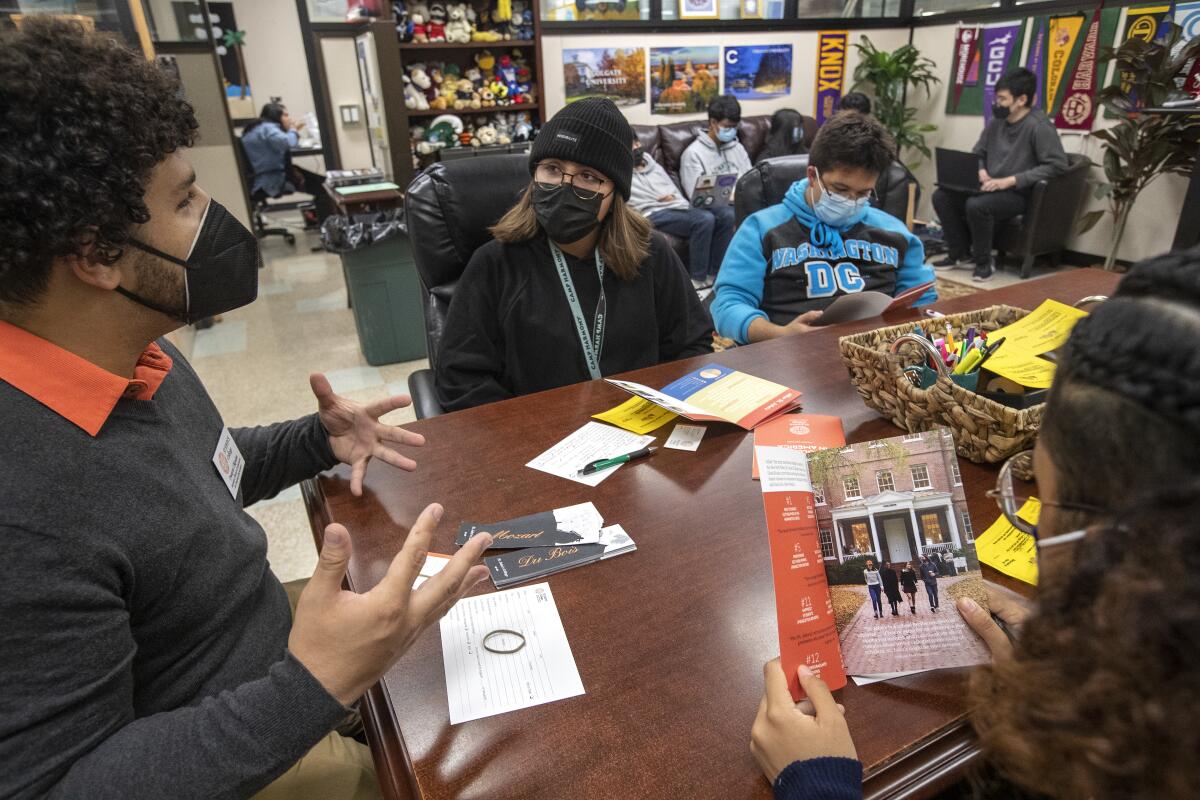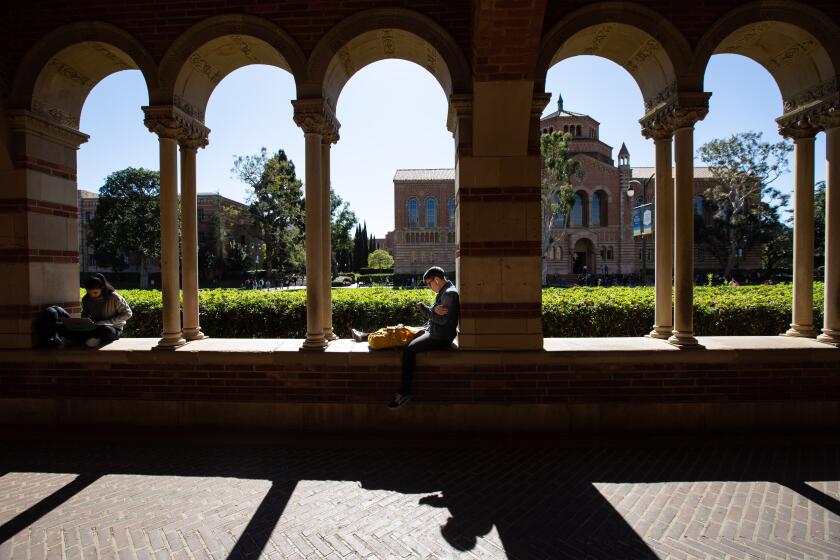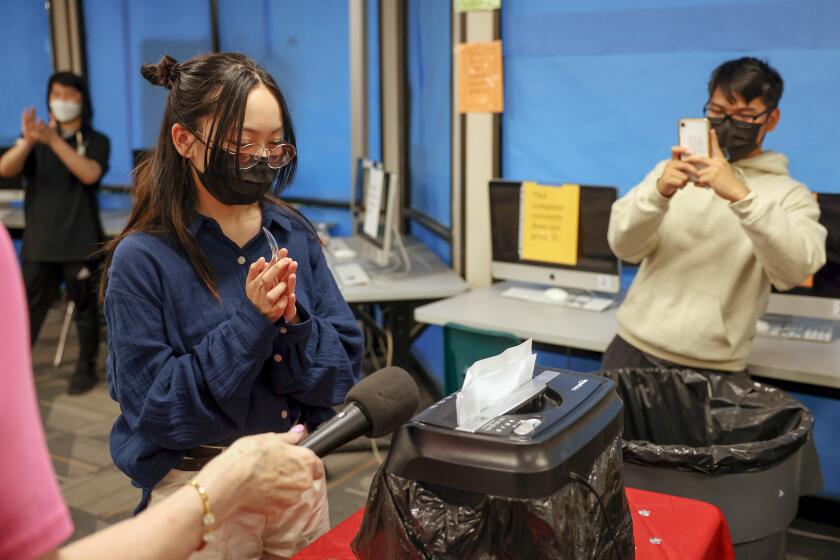You got into your dream school, but it’s pricey. Can California help pay for it?

- Share via
Yajun Chen is an A student but may turn down the University of California for a community college. Eric Xie-McCarthy achieved a 4.6 GPA in a rigorous course load but had to consider forgoing a rich residential experience at his top choice, UC Berkeley, to save money and commute to UCLA. And Nadia Alwiny was accepted into the highly competitive ArtCenter College of Design but was heartbroken when she thought she would have to decline the offer.
These seniors at Downtown Magnets High School in Los Angeles are nearing the end of an arduous, stressful college admissions season — among the most competitive ever. And although many experienced the euphoria of an acceptance letter to their dream school, they are now confronted with the same stark reality facing millions of students in the class of 2022 as the national deadline for college decisions approaches on Sunday.
It’s not enough to receive a hard-earned admission offer. Students and their families have to be able to afford to accept it.
“For many people, financial aid is the make-or-break factor for attending college,” said Eric, whose offer from the University of Illinois Urbana-Champaign was so low — a $5,000 scholarship to cover annual costs of $60,000 — that he quickly declined it.
The University of California drew a record number of first-year applications for fall 2022, with gains in all underrepresented groups; transfer applications fell.
Why student need is increasing
Amid rising college costs and economic uncertainty, students are more dependent than ever on financial aid. More than 70% of 76,000 California students surveyed in 2020 by the California Student Aid Commission said their families had lost part or all of their incomes during the COVID-19 pandemic, and nearly two-thirds said they worried “a lot” about paying for tuition and fees.
A survey of 400 students last year by the California Community Colleges system, whose enrollment plunged during the pandemic, found that affordability and availability of no-loan financial aid were the top factors that would motivate prospective students to enroll. More than one-fourth of those students said they would not consider enrolling because they needed to work full time.
“We know from the data that students are most concerned about how they will pay for college,” said Marlene Garcia, the student aid commission’s executive director. “Many students, especially those attending the community colleges, are dropping out because of costs and are opting to work and stabilize their lives amid the lingering pandemic. What keeps me up at night is whether they will ever come back.”
What California is doing
California is mounting one of its largest-ever efforts to make college affordable — providing more than $1 billion in additional funding for expanded financial aid, affordable student housing and cheaper textbook costs.
Expanded Cal Grants: This past year, state elected officials significantly expanded Cal Grants — already the largest state financial aid program in the nation — by liberalizing eligibility requirements and providing award offers to an additional 140,000 community college students as of November. Lawmakers are proposing additional reforms this year.
Middle-class scholarships: Families making less than $200,000 annually are set to benefit this fall from a fivefold increase in the state Middle Class Scholarship Program. The state is planning to pour an additional $515 million into awards, which will serve nearly 200,000 more California State University students and 113,000 UC students when compared with 2021, according to a report last month by the state Legislative Analyst’s Office. For the first time ever, awards will be based on total cost of college attendance rather than just tuition, providing help to cover housing, food, transportation and other expenses.
The estimated average awards would vary, from about $3,000 for students with annual family incomes between $80,000 and $100,000 to about $1,300 for those earning less than $20,000. Lower-income students would receive smaller average awards because the aid is aimed at covering gaps left by other federal, state and institutional grants.
Aiming for debt-free tuition: The University of California, in a compact this year with Gov. Gavin Newsom, has committed to providing a debt-free education for all undergraduates by 2030 and for half of them by 2025. To help reach that goal, Newsom pledged a 5% annual base budget increase over five years, and the UC regents approved raising tuition once for each incoming first-year class. UC in turn will increase the share of tuition and fee revenue set aside for financial aid from 33% to 45% beginning this fall. The tuition policy will result in $16 million in additional financial aid — $4 million of it from the larger set-aside this year.
In the first installment of its debt-free education plan, UC is offering no-loan financial packages to about 6,000 more students this year, which is expected to cost about $13 million. Berkeley, for instance, offered no-loan packages to 776 first-year students and 329 transfer students this fall, about 5% of its newly admitted students for fall 2022. It also has produced a financial aid navigation guide.
Lower textbooks costs and housing. State leaders are also aiming to lower college expenses by reducing textbook costs and addressing the demand for more affordable student housing. They have launched a $2-billion grant fund over three years for student housing projects. UC additionally has pledged to include requests for student housing in campus fundraising campaigns.
“We’re driving progress on urgent needs like debt-free college, more spaces for students and closing equity gaps,” said Ben Chida, the governor’s chief deputy cabinet secretary. “What’s great is how many leaders are right there with us and all in on this. The next few years will be transformative.”
Native American grants: Beginning this fall, UC will offer tuition-free educations to all California residents who are members of federally recognized Native American, American Indian and Alaska Native tribes. “The University of California is committed to recognizing and acknowledging historical wrongs endured by Native Americans,” UC President Michael V. Drake said in announcing the program.
Without such aid, said Lynda McGee, the college counselor at Downtown Magnets, college would be out of reach for many of her students, who are overwhelmingly low-income.
Most of their parents are immigrants from Latin America and Asia who work as cooks and servers, caretakers and housekeepers, security guards and cashiers. It’s one reason she nudges her students to apply to institutions on the list of no-loan colleges she keeps in her office. A handful of her students have received full-ride offers this year from Yale, Dartmouth, Columbia and other well-endowed but highly selective universities; most of her students, however, will attend California public campuses and take advantage of the state’s generous financial aid programs.
After months of suspense, these unentitled kids and new generation of California’s star college applicants finally get their admission decisions.
The complexities of financial aid
College counselors like McGee say that the expansion of financial aid won’t mean much to students if they don’t know how to apply for it.
“The key to college for my kids is financial aid, but it’s really difficult to understand,” she said. “I constantly go to trainings to stay informed about the changes. How can we expect high school seniors to comprehend something professionals have to continually study?”
Eric can attest to that. When he filled out his federal financial aid application, he included his parents’ retirement funds as assets — only to learn from McGee that they don’t count. After readjusting, his expected annual family contribution dropped from about $8,000 to $3,000 — making him eligible for more Cal Grant aid. That extra financial support will allow him to attend Berkeley and experience dorm living and a full on-campus life rather than attending UCLA as a commuter student.
Eric’s advice to other students: Fill out financial aid applications early — and ask college counselors or other experts for help.
The complexity of the financial aid maze is one reason the California Student Aid Commission is supporting further Cal Grant reforms, such as consolidating eight programs into two. “You need like a PhD in financial aid to be able to understand what a student qualifies for,” said Jake Brymner, the commission’s deputy director of policy and public affairs.
Brymner said an upcoming simplification of FAFSA, the Free Application for Federal Student Aid, would help once it launches in October 2023. And a new state law taking effect this fall will also make a difference, he said, by requiring every school district to make sure all seniors complete a FAFSA or California Dream Act application or intentionally opt out.
Currently, about 56% of the graduating high school class of 2022 has filed for aid, up from 53% last year. Brymner cited promising signs that students most affected by COVID-19 may be reengaging: First-generation college-goers increased financial aid application filings by 5.4% this year over last, with a 9.4% increase among those with annual family incomes at or below $40,000. The increase in applications was partly due to a one-month extension of filing deadlines to April 1, he said.
Making tough choices
At Downtown Magnets, the intense college-going culture has resulted in sky-high filing rates of financial aid applications: 94.4% of seniors. Earlier this month, the school was honored by the California aid commission for having the highest filing rate among schools of its size statewide. McGee shared the credit with the school’s parent educator, Claudia Peña, and her 17 college peer counselors for prodding parents and students to complete the form. In addition, both McGee and teacher Paul Sellier hold sessions on how to read a financial aid letter.
McGee and others also help students become their own advocates. Gia Xin Huang, for instance, was raised by a single mother from China who lost her caretaking job during the pandemic and now scrapes by doing piecemeal sewing for a clothing factory. Her father, who lives separately, is a domestic worker but supplements his meager pay with income from a rental property.
Gia Xin was accepted by her dream school, Wellesley College, but because her father’s property was included in the financial aid calculations, the award offer fell $20,000 short of covering the cost of attendance, she said. In another complexity, McGee said, the assets of a noncustodial parent are not counted in the FAFSA but are included in the College Scholarship Service Profile, another type of financial aid application developed by the nonprofit College Board. It is used by many colleges, including Wellesley, to assess the need for non-federal financial aid.
Gia Xin asserted her leadership skills to file a financial aid appeal to Wellesley — and last week the college granted it. After detailing her family’s financial difficulties and her father’s lack of involvement in her life, Gia Xin received a new financial aid offer that will cover all but $1,950 of the $88,172 annual cost of attendance, including a $75,000 institutional grant from Wellesley.
“It’s kind of a broken system,” she said of the financial aid process, “but it taught me to advocate for myself.”
Nadia also successfully appealed for more financial aid from ArtCenter and, supported by state and federal grants and loans, will be able to accept the offer and pursue her dream to become a game artist.
The UC system’s appeals process, including information and contacts, is outlined on individual campus websites. UCLA, for instance, notes that common reasons for an appeal include changes in income from job loss or divorce, or additional expenses, such as higher rent or medical bills. Appeals must be submitted three weeks before the end of the academic year and UCLA urges applicants to file as quickly as possible because funding is limited.
Unsure of what he will major in, Yajun is leaning toward turning down offers from UC Riverside and UC Merced for a community college — and said he might do so even if he were wealthy. He has learned to be frugal from his father, a chef, and his mother, a supermarket worker. At a community college, he believes he could explore various fields without spending a large sum of money.
“Why spend extra money?” he said. “Why not save it?”
More to Read
Sign up for Essential California
The most important California stories and recommendations in your inbox every morning.
You may occasionally receive promotional content from the Los Angeles Times.













